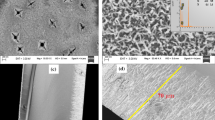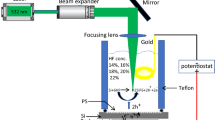Abstract
The present work reports fabrication of polyaniline (PANI)-porous silicon (PS) heterostructure obtained by PANI coating on PS using vacuum coating deposition technique. Electrical properties are studied through the measurement of current (I)–voltage (V) characteristics. Some parameters (viz. ideality factor, barrier height, series resistance) are calculated from the I-V plots. Fitting of these curves is done with the thermionic emission (TE) and Cheung’s method. It is found that Cheung’s method provides better knowledge about the heterostructure in terms of series resistance. The heterostructure comes out as an electrically active material with minimal series resistance of 23.53 kΩ resulting high-driven electric current. The I–V of the heterostructure follows space charge limited conduction (SCLC) mechanism due to the presence of traps or imperfection in the heterostructure. Prior to electrical measurement the device is characterized through field emission scanning electron microscope (FESEM), UV–vis–NIR reflectance, photoluminescence (PL) and Raman spectra for morphological and optical properties. FESEM shows the modified PS structure after PANI deposition revealing short-chained PANI molecules due to thermal treatment. UV–vis-NIR shows lower reflectance of the heterostructure due to impregnation of PANI to the pores of PS resulting change in refractive index. PANI-PS shows quenched PL peak. Raman spectra complement the FESEM results.








Similar content being viewed by others
References
Kim GH, Shao L, Zhang K, Pipe KP (2013) Engineered doping of organic semiconductors for enhanced thermoelectric efficiency. Nat Mater 12:719–723. https://doi.org/10.1038/nmat3635
Wang X, Wang W, Yang C, Han D, Fan H, Zhang J (2021) Thermal transport in organic semiconductors. J Appl Phys 130:170902. https://doi.org/10.1063/5.0062074
Namsheer K, Rout CS (2021) Conducting polymers: a comprehensive review on recent advances in synthesis, properties and applications. RSC Adv 11:5659–5697. https://doi.org/10.1039/D0RA07800J
Jia X, Ge Y, Shao L, Wang C, Wallace GG (2019) Tunable conducting polymers: toward sustainable and versatile batteries. ACS Sustain Chem Eng 7:14321–14340. https://doi.org/10.1021/acssuschemeng.9b02315
McCullough RD, Lowe RD, Jayaraman M, Anderson DL (1993) Design, synthesis, and control of conducting polymer architectures: structurally homogeneous poly(3-alkylthiophenes). J Org Chem 58:904–912. https://doi.org/10.1021/jo00056a024
Adeloju SB, Wallace GG (1996) Conducting polymers and the bioanalytical sciences: new tools for biomolecular communications. A review Analyst 121:699–703. https://doi.org/10.1039/AN9962100699
Kesting RE (1971) Synthetic Polymer Membranes. McGraw-Hill, New York
Kang ET, Neoh KG, Tan KL (1998) Polyaniline: a polymer with many interesting intrinsic redox states. Progress Polym Sci 23:277–324. https://doi.org/10.1016/S0079-6700(97)00030-0
Beygisangchin M, Rashid SA, Shafie S, Sadrolhosseini AR, Lim HN (2021) Preparations, properties, and applications of polyaniline and polyaniline thin films—a review. Polymer 13:2003. https://doi.org/10.3390/polym13122003
Ibrahim KA (2017) Synthesis and characterization of polyaniline and poly(aniline-co-o-nitroaniline) using vibrational spectroscopy. Arab J Chem 10:S2668–S2674. https://doi.org/10.1016/j.arabjc.2013.10.010
Bejbouji H, Vignau L, Miane JL, Dang MT, Oualim EM, Harmouchi M, Mouhsen A (2010) Polyaniline as a hole injection layer on organic photovoltaic cells. Sol Energy Mater Sol Cells 94:176–181. https://doi.org/10.1016/j.solmat.2009.08.018
Illing G, Hellgardt K, Wakeman RJ, Jungbauer A (2001) Preparation and characterisation of polyaniline based membranes for gas separation. J Membr Sci 184:69–78. https://doi.org/10.1016/S0376-7388(00)00606-2
Schauer T, Joos A, Dulog L, Eisenbach CD (1998) Protection of iron against corrosion with polyaniline primers. Prog Org Coat 33:20–27. https://doi.org/10.1016/S0300-9440(97)00123-9
Taymaz BH, Tas R, Kamis H, Can M (2021) Photocatalytic activity of polyaniline and neutral polyaniline for degradation of methylene blue and malachite green dyes under UV Light. Polym Bull 78:2849–2865. https://doi.org/10.1007/s00289-021-03674-1
Kim BH, Jung JH, Hong SH, Kim JW, Choi HJ, Joo J (2001) Physical characterization of emulsion intercalated polyaniline-clay nanocomposite. Curr Appl Phys 1:112–115. https://doi.org/10.1016/S1567-1739(00)00021-3
Jaymand M (2013) Recent progress in chemical modification of polyaniline. Prog Polym Sci 38:1287–1306. https://doi.org/10.1016/j.progpolymsci.2013.05.015
Rai R, Roether JA, Boccaccini AR (2022) Polyaniline based polymers in tissue engineering applications: a review. Prog Biomed Eng 4:042004. https://doi.org/10.1088/2516-1091/ac93d3
Kenry LB (2018) Recent advances in biodegradable conducting polymers and their biomedical applications. Biomacromol 19:1783–1803. https://doi.org/10.1021/acs.biomac.8b00275
Kango S, Kalia S, Celli A, Njuguna J, Habibi Y, Kumar R (2013) Surface modification of inorganic nanoparticles for development of organic–inorganic nanocomposites—a review. Prog Polym Sci 38:1232–1261. https://doi.org/10.1016/j.progpolymsci.2013.02.003
Pei K, Zhai T (2020) Emerging 2D organic-inorganic heterojunction. Cell Rep 1:100166. https://doi.org/10.1016/j.xcrp.2020.100166
Era M, Morimoto S, Tsutsui T, Saito S (1994) Organic-inorganic heterostructure electroluminescent device using a layered perovskite semiconductor (C6H5C2H4NH3)2PbI4. Appl Phys Lett 65:676–678. https://doi.org/10.1063/1.112265
Chowdhury A, Biswas B, Bera RN, Malik B (2012) Nanostructured organic–inorganic heterojunction diodes as gas sensors. RSC Adv 2:10968–10976. https://doi.org/10.1039/c2ra20758c
Xiong P, Wu Y, Liu Y, Ma R, Sasaki T, Wang X, Zhu J (2020) Two-dimensional organic–inorganic superlattice-like heterostructures for energy storage applications. Energy Environ Sci 13:4834–4853. https://doi.org/10.1039/D0EE03206A
Jangid NK, Jadoun S, Yadav A, Srivastava M, Kaur N (2021) Polyaniline- TiO2- based photocatalysts for dyes degradation. Polym Bull 78:4743–4777. https://doi.org/10.1007/s00289-020-03318-w
Raghu MS, Kumar KY, Rao S, Aravinda T, Prasanna BP, Prashanth MK (2018) Fabrication of polyaniline- few- layer MoS2 nanocomposite for high energy density supercapacitors. Polym Bull 75:4359–4375. https://doi.org/10.1007/s00289-017-2267-9
Pavesi L, Dal NL, Mazzoleni C, Franzo G, Priolo F (2000) Optical gain in silicon nanocrystals. Nature 408:440–444. https://doi.org/10.1038/35044012
Fan JY, Wu XL, Li HX, Liu HW, Huang GS, Siu GG, Chu PK (2006) Si-based solid blue emitters from 3C-SiC nanocrystals. Appl Phys A 82:485–487. https://doi.org/10.1007/s00339-005-3445-4
Lin H, Gao T, Fantini J, Sailor MJ (2004) A porous silicon-palladium composite film for optical interferometric sensing of hydrogen. Langmuir 20:5104–5108. https://doi.org/10.1021/la049741u
Lehmann V, Gosele U (1991) Porous silicon formation: a quantum wire effect. Appl Phys Lett 58:856–858. https://doi.org/10.1063/1.104512
Mynbaeva M, Sitnikova A, Treguboya A, Mynbaev K (2007) HVPE GaN growth on porous SiC with closed surface porosity. J Cryst Growth 303:472–479. https://doi.org/10.1016/j.jcrysgro.2006.12.041
Farag AAM, Ashrey A, Terra FS (2008) Fabrication and electrical characterization of n-InSb on porous Si heterojunctions prepared by liquid phase epitaxy. Microelectronics J 39:253–260. https://doi.org/10.1016/j.mejo.2007.10.029
Anderson SHC, Elliott H, Wallis DJ, Canham LT, Powell JJ (2003) Dissolution of different forms of partially porous silicon wafers under simulated physiological conditions. Phys Status Solidi A 197:331–335. https://doi.org/10.1002/pssa.200306519
Mula G, Manca L, Setzu S, Pezzella A (2012) Photovoltaic properties of PSi impregnated with eumelanin. Nanoscale Res Lett 7:377. https://doi.org/10.1186/1556-276x-7-377
Urbach B, Korbakov N, Bar-David Y, Yitzchaik S, Sa’ar A (2007) Composite structures of polyaniline and mesoporous silicon: electrochemistry, optical and transport properties. J Phys Chem C 111:16586–16592. https://doi.org/10.1021/jp073647f
Nahor A, Berger O, Bardavid Y, Toker G, Tamar Y, Reiss L, Asscher M, Yitzchaik S, Sa’ar A (2011) Hybrid structures of porous silicon and conjugated polymers for photovoltaic applications. Phys Status Solidi C 8:1908–1912. https://doi.org/10.1002/pssc.201000203
Nahor A, Shalev I, Sa’ar A, Yitzchaik S (2015) Optical and electrooptical properties of porous-silicon/conjugated-polymer composite structures. Eur J Inorg Chem 2015:1212–1217. https://doi.org/10.1002/ejic.201402450
Kumar P, Adhikari S, Benerji P (2010) Fabrication and characterization of polyaniline/porous silicon heterojunction. Synth Met 160:1507–1512. https://doi.org/10.1016/j.synthmet.2010.05.011
Betty CA (2009) Highly sensitive capacitive immunosensor based on porous silicon polyaniline structure: bias dependence on specificity. Biosens Bioelectron 25:338–343. https://doi.org/10.1016/j.bios.2009.07.009
Bisi O, Ossicini S, Pavesi L (2000) Porous silicon: a quantum sponge structure for silicon based optoelectronics. Surf Sci Rep 38:1–126. https://doi.org/10.1016/s1067-5729(99)00012-6
Tiddia M, Mula G, Mascia M, Sechib E, Vacca A (2016) Porous silicon–polyaniline hybrid composites synthesized through electroreduction of an aryldiazonium salt: preparation and photocurrent properties. Rsc Adv 6:101880–101887. https://doi.org/10.1039/c6ra19868f
Halliday DP, Holland ER, Eggleston JM, Adams PN, Cox SE, Monkman AP (1996) Electroluminescence from porous silicon using a conducting polyaniline contact. Thin Solid Films 276:299–302. https://doi.org/10.1016/0040-6090(95)08102-x
Bsiesy A, Nicolau YF, Ermolieff A, Muller F, Gaspard F (1995) Electroluminescence from n+ -type porous silicon contacted with layer-by-layer deposited polyaniline. Thin Solid Films 255:43–48. https://doi.org/10.1016/0040-6090(95)91136-A
Das M, Nath P, Sarkar D (2016) Influence of etching current density on microstructural, optical and electrical properties of porous silicon (PS):n-Siheterostructure. Superlatt Microstruct 90:77–86. https://doi.org/10.1016/j.spmi.2015.12.008
Sailor MJ (2011) Porous silicon in practice. Willey-VCH, Germany, p 91
Dubey RS, Gautom DK (2009) Fabrication and characterization of porous silicon layers for applications in optoelectronics. Opt Quantum Electron 41:189–201. https://doi.org/10.1007/s11082-009-9341-y
Ding J, Li X, Wang X, Zhang J, Yu D, Qiu B (2015) Fabrication of vertical array CNTs/polyaniline composite membranes by microwave-assisted in situ polymerization. Nanoscale Res. Lett. 10:493. https://doi.org/10.1186/s11671-015-1201-z
Abdullah HS (2012) Electrochemical polymerization and Raman study of polypyrrole and polyaniline thin films. Int J Phys Sci 38:5468–5476. https://doi.org/10.5897/IJPS12.529
Zhu M, Zhang J, Hou H (2012) Fabrication and electrical characteristics of the Pt/SiNWs/n-Si/Al Schottky diode structure. Microelectron Eng 95:112–115. https://doi.org/10.1016/j.mee.2012.02.009
Karatas S, Yakuphanoglu F (2013) Effects of illumination on electrical parameters of Ag/n-CdO/p-Si diode. Mater Chem Phys 138:72–77. https://doi.org/10.1016/j.matchemphys.2012.10.038
Sze SM (1981) Physics of semiconductor devices, 2nd edn. Wiley, New York
Hanselaer PL, Laflere WH, Van Meirhaeghe RL, Cardon F (1984) Current-voltage characteristic of Ti-pSi metal-oxide-semiconductor diodes. J App Phys 56:2309. https://doi.org/10.1063/1.334265
Rhoderick EH (1978) Metal semiconductor contacts. Oxford University Press, Oxford
Cheung SK, Cheung NW (1986) Extraction of Schottky diode parameters from forward current voltage characteristics. Appl Phys Lett 49:85–87. https://doi.org/10.1063/1.97359
Newman N, Schilfgaarde MV, Kendelwicz T, Williams MD, Spicer WE (1986) Electrical study of Schottky barriers on atomically clean GaAs(110) surfaces. Phys Rev B 33:1146. https://doi.org/10.1103/PhysRevB.33.1146
Aydin ME, Türüt A (2007) The electrical characteristics of Sn/methyl-red/p-type Si/Al contacts. Microelectron Eng 84:2875–2882. https://doi.org/10.1016/j.mee.2007.02.010
Aydogan S, Incekara U, Deniz AR, Turut A (2010) Extraction of electronic parameters of Schottky diode based on an organic Orcein. Microelectron Eng 87:2525–2530. https://doi.org/10.1016/j.mee.2010.06.004
Son DI, Park DH, Choi WK, Cho SH, Kim WT, Kim TW (2009) Carrier transport in flexible organic bistable devices of ZnO nanoparticles embedded in an insulating poly(methyl methacrylate) polymer layer. Nanotechnology 20:195203. https://doi.org/10.1088/0957-4484/20/19/195203
Yamamoto H, Kasajima H, Yokoyama W, Sasabe H, Adachi C (2005) Extremely-high-density carrier injection and transport over 12000 A/cm2 into organic thin films. Appl Phys Lett 86:083502. https://doi.org/10.1063/1.1866230
El-Zohary SE, Shenashen MA, Allam NK, Okamoto T, Haraguchi M (2013) Electrical characterization of nanopolyaniline/porous silicon heterojunction at high temperatures. J Nanomater 2013:568175. https://doi.org/10.1155/2013/568175
Saglam M, Biber M, Cakar M, Turut A (2004) The effects of the ageing on the characteristic parameters of polyaniline/p-type Si/Al structure. Appl Surf Sci 230:404–410. https://doi.org/10.1016/j.apsusc.2004.03.003
Acknowledgements
Authors acknowledge University Grant Commission (Project Grant No. 40-438/2011 SR), Department of Science and Technology (Project Grant No. DST/TSG/PT2009/96) and DST-FIST for providing instrumental facility through project grants. Authors are thankful to IIT Guwahati for UV–vis–NIR reflectance measurements and to Dr. M. P. C Kalita, Department of Physics, Gauhati University for PL measurements and technical support.
Author information
Authors and Affiliations
Corresponding author
Additional information
Publisher's Note
Springer Nature remains neutral with regard to jurisdictional claims in published maps and institutional affiliations.
Rights and permissions
Springer Nature or its licensor (e.g. a society or other partner) holds exclusive rights to this article under a publishing agreement with the author(s) or other rightsholder(s); author self-archiving of the accepted manuscript version of this article is solely governed by the terms of such publishing agreement and applicable law.
About this article
Cite this article
Nath, P., Sarkar, D. Electrical properties of polyaniline (PANI)-porous silicon (PS) heterostructure. Polym. Bull. 81, 2329–2343 (2024). https://doi.org/10.1007/s00289-023-04820-7
Received:
Revised:
Accepted:
Published:
Issue Date:
DOI: https://doi.org/10.1007/s00289-023-04820-7




